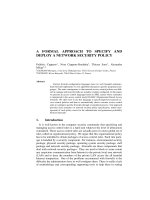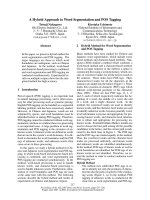a combinatorial approach to mattrix theory and ita applications
Bạn đang xem bản rút gọn của tài liệu. Xem và tải ngay bản đầy đủ của tài liệu tại đây (1.44 MB, 284 trang )
A C
A
M T
I A
C8223_FM.indd 1
7/1/08 12:18:04 PM
C8223_FM.indd 2
7/1/08 12:18:04 PM
DISCRETE
MATHEMATICS
ITS APPLICATIONS
Series Editor
Kenneth H. Rosen, Ph.D.
Juergen Bierbrauer, Introduction to Coding Theory
Francine Blanchet-Sadri, Algorithmic Combinatorics on Partial Words
Richard A. Brualdi and Drago˘s Cvetkovi´c, A Combinatorial Approach to Matrix Theory and Its Applications
Kun-Mao Chao and Bang Ye Wu, Spanning Trees and Optimization Problems
Charalambos A. Charalambides, Enumerative Combinatorics
Henri Cohen, Gerhard Frey, et al., Handbook of Elliptic and Hyperelliptic Curve Cryptography
Charles J. Colbourn and Jeffrey H. Dinitz, Handbook of Combinatorial Designs, Second Edition
Martin Erickson and Anthony Vazzana, Introduction to Number Theory
Steven Furino, Ying Miao, and Jianxing Yin, Frames and Resolvable Designs: Uses, Constructions,
and Existence
Randy Goldberg and Lance Riek, A Practical Handbook of Speech Coders
Jacob E. Goodman and Joseph O’Rourke, Handbook of Discrete and Computational Geometry,
Second Edition
Jonathan L. Gross, Combinatorial Methods with Computer Applications
Jonathan L. Gross and Jay Yellen, Graph Theory and Its Applications, Second Edition
Jonathan L. Gross and Jay Yellen, Handbook of Graph Theory
Darrel R. Hankerson, Greg A. Harris, and Peter D. Johnson, Introduction to Information Theory and
Data Compression, Second Edition
Daryl D. Harms, Miroslav Kraetzl, Charles J. Colbourn, and John S. Devitt, Network Reliability:
Experiments with a Symbolic Algebra Environment
Leslie Hogben, Handbook of Linear Algebra
Derek F. Holt with Bettina Eick and Eamonn A. O’Brien, Handbook of Computational Group Theory
David M. Jackson and Terry I. Visentin, An Atlas of Smaller Maps in Orientable and Nonorientable
Surfaces
Richard E. Klima, Neil P. Sigmon, and Ernest L. Stitzinger, Applications of Abstract Algebra
with Maple™ and MATLAB®, Second Edition
Patrick Knupp and Kambiz Salari, Verification of Computer Codes in Computational Science
and Engineering
C8223_FM.indd 3
7/1/08 12:18:04 PM
Continued Titles
William Kocay and Donald L. Kreher, Graphs, Algorithms, and Optimization
Donald L. Kreher and Douglas R. Stinson, Combinatorial Algorithms: Generation Enumeration and Search
Charles C. Lindner and Christopher A. Rodgers, Design Theory
Hang T. Lau, A Java Library of Graph Algorithms and Optimization
Alfred J. Menezes, Paul C. van Oorschot, and Scott A. Vanstone, Handbook of Applied Cryptography
Richard A. Mollin, Algebraic Number Theory
Richard A. Mollin, Codes: The Guide to Secrecy from Ancient to Modern Times
Richard A. Mollin, Fundamental Number Theory with Applications, Second Edition
Richard A. Mollin, An Introduction to Cryptography, Second Edition
Richard A. Mollin, Quadratics
Richard A. Mollin, RSA and Public-Key Cryptography
Carlos J. Moreno and Samuel S. Wagstaff, Jr., Sums of Squares of Integers
Dingyi Pei, Authentication Codes and Combinatorial Designs
Kenneth H. Rosen, Handbook of Discrete and Combinatorial Mathematics
Douglas R. Shier and K.T. Wallenius, Applied Mathematical Modeling: A Multidisciplinary Approach
Jörn Steuding, Diophantine Analysis
Douglas R. Stinson, Cryptography: Theory and Practice, Third Edition
Roberto Togneri and Christopher J. deSilva, Fundamentals of Information Theory and Coding Design
W. D. Wallis, Introduction to Combinatorial Designs, Second Edition
Lawrence C. Washington, Elliptic Curves: Number Theory and Cryptography, Second Edition
C8223_FM.indd 4
7/1/08 12:18:04 PM
DISCRETE MATHEMATICS AND ITS APPLICATIONS
Series Editor KENNETH H. ROSEN
A C
A
M T
I A
RICH ARD A. BR UALDI
Uni ve rsi t y of W i sconsin — M a di son
U . S . A.
DR AGO˘
S CVET K OV I´
C
Uni ve rsi t y of Belgr a de
S e r bi a
C8223_FM.indd 5
7/1/08 12:18:04 PM
Chapman & Hall/CRC
Taylor & Francis Group
6000 Broken Sound Parkway NW, Suite 300
Boca Raton, FL 33487-2742
© 2009 by Taylor & Francis Group, LLC
Chapman & Hall/CRC is an imprint of Taylor & Francis Group, an Informa business
No claim to original U.S. Government works
Printed in the United States of America on acid-free paper
10 9 8 7 6 5 4 3 2 1
International Standard Book Number-13: 978-1-4200-8223-4 (Hardcover)
This book contains information obtained from authentic and highly regarded sources. Reasonable
efforts have been made to publish reliable data and information, but the author and publisher cannot assume responsibility for the validity of all materials or the consequences of their use. The
authors and publishers have attempted to trace the copyright holders of all material reproduced
in this publication and apologize to copyright holders if permission to publish in this form has not
been obtained. If any copyright material has not been acknowledged please write and let us know so
we may rectify in any future reprint.
Except as permitted under U.S. Copyright Law, no part of this book may be reprinted, reproduced,
transmitted, or utilized in any form by any electronic, mechanical, or other means, now known or
hereafter invented, including photocopying, microfilming, and recording, or in any information
storage or retrieval system, without written permission from the publishers.
For permission to photocopy or use material electronically from this work, please access www.copyright.com ( or contact the Copyright Clearance Center, Inc. (CCC), 222
Rosewood Drive, Danvers, MA 01923, 978-750-8400. CCC is a not-for-profit organization that provides licenses and registration for a variety of users. For organizations that have been granted a
photocopy license by the CCC, a separate system of payment has been arranged.
Trademark Notice: Product or corporate names may be trademarks or registered trademarks, and
are used only for identification and explanation without intent to infringe.
Library of Congress Cataloging-in-Publication Data
Brualdi, Richard A.
A combinatorial approach to matrix theory and its applications / Richard A.
Brualdi, Dragos Cvetkovic.
p. cm. -- (Discrete mathematics and its applications ; 52)
Includes bibliographical references and index.
ISBN 978-1-4200-8223-4 (hardback : alk. paper)
1. Matrices. 2. Combinatorial analysis. I. Cvetkovic, Dragoš M. II. Title. III.
Series.
QA188.B778 2008
512.9’434--dc22
2008014627
Visit the Taylor & Francis Web site at
and the CRC Press Web site at
C8223_FM.indd 6
7/1/08 12:18:04 PM
Contents
Preface
xi
Dedication
xv
1 Introduction
1.1 Graphs . . . . . . . . . . . . .
1.2 Digraphs . . . . . . . . . . . .
1.3 Some Classical Combinatorics
1.4 Fields . . . . . . . . . . . . .
1.5 Vector Spaces . . . . . . . . .
1.6 Exercises . . . . . . . . . . . .
.
.
.
.
.
.
.
.
.
.
.
.
.
.
.
.
.
.
.
.
.
.
.
.
.
.
.
.
.
.
.
.
.
.
.
.
.
.
.
.
.
.
.
.
.
.
.
.
.
.
.
.
.
.
.
.
.
.
.
.
.
.
.
.
.
.
.
.
.
.
.
.
1
2
8
10
13
17
23
2 Basic Matrix Operations
2.1 Basic Concepts . . . . . . . . .
2.2 The K¨onig Digraph of a Matrix
2.3 Partitioned Matrices . . . . . .
2.4 Exercises . . . . . . . . . . . . .
.
.
.
.
.
.
.
.
.
.
.
.
.
.
.
.
.
.
.
.
.
.
.
.
.
.
.
.
.
.
.
.
.
.
.
.
.
.
.
.
.
.
.
.
27
27
35
43
46
3 Powers of Matrices
3.1 Matrix Powers and Digraphs . .
3.2 Circulant Matrices . . . . . . .
3.3 Permutations with Restrictions
3.4 Exercises . . . . . . . . . . . . .
.
.
.
.
.
.
.
.
.
.
.
.
.
.
.
.
.
.
.
.
.
.
.
.
.
.
.
.
.
.
.
.
.
.
.
.
.
.
.
.
.
.
.
.
49
49
58
59
60
4 Determinants
63
4.1 Definition of the Determinant . . . . . . . . . . . . 63
4.2 Properties of Determinants . . . . . . . . . . . . . . 72
4.3 A Special Determinant Formula . . . . . . . . . . . 85
vii
viii
CONTENTS
4.4 Classical Definition of the Determinant . . . . . . .
4.5 Laplace Determinant Development . . . . . . . . .
4.6 Exercises . . . . . . . . . . . . . . . . . . . . . . . .
5 Matrix Inverses
5.1 Adjoint and Its Determinant . .
5.2 Inverse of a Square Matrix . . .
5.3 Graph-Theoretic Interpretation
5.4 Exercises . . . . . . . . . . . . .
.
.
.
.
.
.
.
.
.
.
.
.
.
.
.
.
.
.
.
.
6 Systems of Linear Equations
6.1 Solutions of Linear Systems . . . . . . .
6.2 Cramer’s Formula . . . . . . . . . . . . .
6.3 Solving Linear Systems by Digraphs . . .
6.4 Signal Flow Digraphs of Linear Systems
6.5 Sparse Matrices . . . . . . . . . . . . . .
6.6 Exercises . . . . . . . . . . . . . . . . . .
7 Spectrum of a Matrix
7.1 Eigenvectors and Eigenvalues .
7.2 The Cayley–Hamilton Theorem
7.3 Similar Matrices and the JCF .
7.4 Spectrum of Circulants . . . . .
7.5 Exercises . . . . . . . . . . . . .
.
.
.
.
.
.
.
.
.
.
8 Nonnegative Matrices
8.1 Irreducible and Reducible Matrices
8.2 Primitive and Imprimitive Matrices
8.3 The Perron–Frobenius Theorem . .
8.4 Graph Spectra . . . . . . . . . . . .
8.5 Exercises . . . . . . . . . . . . . . .
9 Additional Topics
9.1 Tensor and Hadamard Product
9.2 Eigenvalue Inclusion Regions . .
9.3 Permanent and SNS-Matrices .
9.4 Exercises . . . . . . . . . . . . .
.
.
.
.
.
.
.
.
.
.
.
.
.
.
.
.
.
.
.
.
.
.
.
.
.
.
.
.
.
.
.
.
.
.
.
.
.
.
.
.
.
.
.
.
.
.
.
.
.
.
.
.
.
.
.
.
.
.
.
.
.
.
.
.
.
.
.
.
.
.
.
.
.
.
.
.
.
.
.
.
.
.
.
.
.
.
.
.
.
.
.
.
.
.
.
.
.
.
.
.
.
.
.
.
.
.
.
.
.
.
.
.
.
.
.
.
.
.
.
.
.
.
.
.
.
.
.
.
.
.
.
.
.
.
.
.
.
.
.
.
.
.
.
.
.
.
87
91
94
.
.
.
.
97
. 97
. 101
. 103
. 107
.
.
.
.
.
.
.
.
.
.
.
.
109
109
118
121
127
133
137
.
.
.
.
.
139
139
147
150
165
167
.
.
.
.
.
171
171
174
179
184
188
.
.
.
.
191
191
196
204
215
.
.
.
.
.
.
.
.
.
.
.
.
.
.
ix
CONTENTS
10 Applications
10.1 Electrical Engineering: Flow Graphs .
10.2 Physics: Vibration of a Membrane . . .
10.3 Chemistry: Unsaturated Hydrocarbons
10.4 Exercises . . . . . . . . . . . . . . . . .
.
.
.
.
.
.
.
.
.
.
.
.
.
.
.
.
.
.
.
.
.
.
.
.
.
.
.
.
217
218
224
229
240
Coda
241
Answers and Hints
245
Bibliography
253
Index
261
Preface
Matrix theory is a fundamental area of mathematics with applications not only to many branches of mathematics but also to science and engineering. Its connections to many different branches
of mathematics include: (i) algebraic structures such as groups,
fields, and vector spaces; (ii) combinatorics, including graphs and
other discrete structures; and (iii) analysis, including systems of
linear differential equations and functions of a matrix argument.
Generally, elementary (and some advanced) books on matrices ignore or only touch on the combinatorial or graph-theoretical
connections with matrices. This is unfortunate in that these connections can be used to shed light on the subject, and to clarify and
deepen one’s understanding. In fact, a matrix and a (weighted)
graph can each be regarded as different models of the same mathematical concept.
Most researchers in matrix theory, and most users of its methods, are aware of the importance of graphs in linear algebra. This
can be seen from the great number of papers in which graphtheoretic methods for solving problems in linear algebra are used.
Also, electrical engineers apply these methods in practical work.
But, in most instances, the graph is considered as an auxiliary,
but nonetheless very useful, tool for solving important problems.
This book differs from most other books on matrices in that
the combinatorial, primarily graph-theoretic, tools are put in the
forefront of the development of the theory. Graphs are used to
explain and illuminate basic matrix constructions, formulas, computations, ideas, and results. Such an approach fosters a better
understanding of many ideas of matrix theory and, in some instances, contributes to easier descriptions of them. The approach
xi
xii
PREFACE
taken in this book should be of interest to mathematicians, electrical engineers, and other specialists in sciences such as chemistry
and physics.
Each of us has written a previous book that is related to the
present book:
I. R. A. Brualdi, H. J. Ryser, Combinatorial Matrix Theory,
Cambridge: Cambridge University Press, 1991; reprinted
1992.
II. D. Cvetkovi´c, Combinatorial Matrix Theory, with Applications to Electrical Engineering, Chemistry and Physics, (in
Serbian), Beograd: Nauˇcna knjiga, 1980; 2nd ed. 1987.
This joint book came about as a result of a proposal from the
second-named author (D.C.) to the first-named author (R.A.B.)
to join in reworking and translating (parts of) his book (II). While
that book—mainly the theoretical parts of it—has been used as
a guide in preparing this book, the material has been rewritten
in a major way with some new organization and with substantial
new material added throughout. The stress in this book is on
the combinatorial aspects of the topics treated; other aspects of
the theory (e.g., algebraic and analytic) are described as much as
necessary for the book to be reasonably self-contained and to provide some coherence. Some material that is rarely found in books
at this level, for example, Ger˘sgorin’s theorem and its extensions,
Kronecker product of matrices, and sign-nonsingular matrices and
evaluation of the permanent, is included in the book.
Thus our goal in writing this book is to increase one’s understanding of and intuition for the fundamentals of matrix theory,
and its application to science, with the aid of combinatorial/graphtheoretic tools. The book is not written as a first course in linear
algebra. It could be used in a special course in matrix theory for
students who know the basics of vector spaces. More likely, this
book could be used as a supplementary book for courses in matrix
theory (or linear algebra). It could also be used as a book for an
undergraduate seminar or as a book for self-study.
We now briefly describe the chapters of the book. In the first
chapter we review the basics and terminology of graph theory,
PREFACE
xiii
elementary counting formulas, fields, and vector spaces. It is expected that someone reading this book has a previous acquaintence with vector spaces. In Chapter 2 the algebra of matrices
is explained, and the K¨onig digraph is introduced and then used
in understanding and carrying out basic matrix operations. The
short Chapter 3 is concerned with matrix powers and their description in terms of another digraph associated with a matrix.
In Chapter 4 we introduce the Coates digraph of a matrix and
use it to give a graph-theoretic definition of the determinant. The
fundamental properties of determinants are established using the
Coates digraph. These include the Binet–Cauchy formula and the
Laplace development of the determinant along a row or column.
The classical formula for the determinant is also derived. Chapter
5 is concerned with matrix inverses and a graph-theoretic interpretation is given. In Chapter 6 we develop the elementary theory of
solutions of systems of linear equations, including Cramer’s rule,
and show how the Coates digraph can be used to solve a linear
system. Some brief mention is made of sparse matrices.
In Chapter 7 we study the eigenvalues, eigenvectors, and characteristic polynomial of a matrix. We give a combinatorial argument for the classical Cayley–Hamilton theorem and a very combinatorial proof of the Jordan canonical form of a matrix. Chapter
8 is about nonnegative matrices and their special properties that
highly depend on their digraphs. We discuss, but do not prove,
the important properties of nonnegative matrices that are part of
the Perron–Frobenius theory. We also describe some basic properties of graph spectra. There are three unrelated topics in Chapter
9, namely, Kronecker products of matrices, eigenvalue inclusion
regions, and the permanent of a matrix and its connection with
sign-nonsingular matrices. In Chapter 10 we describe some applications in electrical engineering, physics, and chemistry.
Our hope is that this book will be useful for both students,
teachers, and users of matrix theory.
Richard A. Brualdi
Dragoˇs Cvetkovi´c
Dedication
To Les and Carol Brualdi for keeping the family together
Richard A. Brualdi
To my grandchildren Nebojˇsa and Katarina Cvetkovi´c
Drago˘s Cvetkovi´c
Chapter 1
Introduction
In this introductory chapter, we discuss ideas and results from
combinatorics (especially graph theory) and algebra (fields and
vector spaces) that will be used later. Analytical tools, as well as
the elements of polynomial theory, which are sometimes used in
this book, are not specifically mentioned or defined, believing, as
we do, that the reader will be familiar with them. In accordance
with the goals of this book, vector spaces are described in a very
limited way. The emphasis of this book is on matrix theory and
computation, and not on linear algebra in general.
The first two sections are devoted to the basic concepts of graph
theory. In Section 1.1 (undirected) graphs are introduced while
Section 1.2 is concerned with digraphs (directed graphs). Section
1.3 gives a short overview of permutations and combinations of
finite sets, including their enumeration. The last two sections
contain algebraic topics. Section 1.4 summarizes basic facts on
fields while Section 1.5 reviews the basic structure of vector spaces
of n-tuples over a field.
Matrices, the main objects of study in this book, will be introduced in the next chapter. They act on vector spaces but,
together with many algebraic properties, contain much combinatorial, in particular, graph-theoretical, structure. In this book we
exploit these combinatorial properties of matrices to present and
explain many of their basic features.
1
2
1.1
CHAPTER 1. INTRODUCTION
Graphs
The basic notions of graph theory are very intuitive, and as a result
we shall dispense with some formality in our explanations. Most
of what follows consists of definitions and elementary properties.
Definition 1.1.1 A graph G consists of a finite set V of elements
called vertices and a set E of unordered pairs of vertices called
edges. The order of the graph G is the number |V | of its vertices.
If α = {x, y} is an edge, then α joins vertices x and y, and x and
y are vertices of the edge α. If x = y, then α is a loop. A subgraph
of G is a graph H with vertex set W ⊆ V whose edges are some,
possibly all, of the edges of G joining vertices in W . The subgraph
H is a induced subgraph of G provided each edge of G that joins
vertices in W is also an edge of H. The subgraph H is a spanning
subgraph of G provided W = V , that is, provided H contains all
the vertices of G (but not necessarily all the edges). A multigraph
differs from a graph in that there may be several edges joining the
same two vertices. Thus the edges of a multigraph form a multiset
of pairs of vertices. A weighted graph is a graph in which each edge
has an assigned weight (generally, a real or complex number). If all
the weights of a graph G are positive integers, then the weighted
graph could be regarded as a multigraph G′ with the weight of an
edge {x, y} in G regarded as the number of edges in G′ joining the
vertices x and y.
✷
G
H1
H2
Figure 1.1
Graphs can be pictured geometrically by representing each vertex by a (geometric) point in the plane, and each edge by a (geometric) edge, that is, a straight line or curve joining corresponding
1.1. GRAPHS
3
geometric points. Care needs to be taken so that a geometric edge,
except for its two endpoints, contains no other point representing
a vertex of the graph. A graph G and two subgraphs H1 and H2
are drawn in Figure 1.1. The graph H1 is a spanning subgraph
of G; the graph H2 is not a spanning subgraph but is an induced
subgraph.
Definition 1.1.2 Let G be a graph. A walk in G, joining vertices
u and v, is a sequence γ of vertices u = x0 , x1 , . . . , xk−1, xk = y
such that {xi , xi+1 } is an edge for each i = 0, 1, . . . , k − 1. The
edges of the walk γ are these k edges, and the length of γ is k. If
u = v, then γ is a closed walk. If the vertices x0 , x1 , . . . , xk−1 , xk
are distinct, then γ is a path joining u and v. If u = v and the
vertices x0 , x1 , . . . , xk−1 , xk are otherwise distinct, then γ is a cycle.
The graph G is connected provided that for each pair of distinct
vertices u and v there is a walk joining u and v. A graph that is
not connected is called disconnected.
✷
It is to be noted that if there is a walk γ joining vertices u and v,
then there is a path joining u and v. Such a path can be obtained
from γ by eliminating cycles as they are formed in traversing γ.
A path has one fewer edge than it has vertices. The number of
vertices of a cycle equals the number of its edges. We sometimes
regard a path (respectively, cycle) as a graph whose vertices are
the vertices on the path (respectively, cycle) and whose edges are
the edges of the path (respectively, cycle). A path with n vertices
is denoted by Pn , and a cycle with n vertices is denoted by Cn .
Definition 1.1.3 Let G be a graph with vertex set V . Define
u ≡ v provided there is a walk joining u and v in G. Then it
is easy to verify that this is an equivalence relation and thus V
is partitioned into equivalence classes V1 , V2 , . . . , Vl whereby two
vertices are joined by a walk in G if and only if they are in the
same equivalence class. The subgraphs of G induced on the sets
of vertices V1 , V2 , . . . , Vl are the connected components of G. The
graph G is connected if and only if it has exactly one connected
component.
4
CHAPTER 1. INTRODUCTION
A tree is a connected graph with no cycles. A spanning tree
of G is a spanning subgraph of G that is a tree. Only connected
graphs have a spanning tree, and a spanning tree can be obtained
by recursively removing an edge of a cycle until no cycles remain.
The graph in Figure 1.2 is a tree with 5 vertices and 4 edges. A
forest is a graph each of whose connected components is a tree. ✷
Figure 1.2
The next theorem contains some basic properties of trees.
Theorem 1.1.4 Let G be a graph of order n ≥ 2 without any
loops. The following are equivalent:
(i) G is a tree.
(ii) For each pair of distinct vertices u and v there is a unique
path joining u and v.
(iii) G is connected and has exactly n − 1 edges.
(iv) G is connected and removing an edge of G always results in
a disconnected graph.
✷
An edge of a connected graph whose removal results in a disconnected graph is called a bridge. A bridge cannot be an edge of
any cycle. Property (iv) above thus asserts that a graph is a tree
if and only if it is connected and every edge is a bridge.
In Figure 1.3 we show all the structurally different trees of
order k with k ≤ 5.
5
1.1. GRAPHS
Definition 1.1.5 In a graph G (or multigraph) the degree of a
vertex u is the number of edges containing u where, in the case of a
loop, there is a contribution of 2 to the degree. Let G be of order n,
and let the degrees of its vertices be d1 , d2, . . . , dn , where, without
loss of generality, we may assume that d1 ≥ d2 ≥ · · · ≥ dn ≥ 0.
Then d1 , d2 , . . . , dn is the degree sequence of G. Since each edge
contributes 1 to the degree of two vertices, or, in the case of loops,
2 to the degree of one vertex, we have
d1 + d2 + · · · + dn = 2e,
where e is the number of edges. A graph is regular provided each
vertex has the same degree. If k is the common degree, then the
graph is regular of degree k. A connected regular graph of degree
2 is a circuit. A pendent vertex of a graph is a vertex of degree
1. The unique edge containing a particular pendent vertex is a
pendent edge.
✷
Figure 1.3
The complete graph Kn of order n is the graph in which each
pair of distinct vertices forms an edge. Thus Kn is a regular graph
of degree n and has exactly n(n − 1)/2 edges. Since a tree of order
n has n − 1 edges, the sum of the degrees of its vertices equals
2(n − 1). Thus a tree of order n ≥ 2 has at least two pendent
vertices, and indeed has exactly 2 pendent vertices if and only if
it is a path. Removing a pendent vertex–pendent edge pair from
a tree leaves a tree of order 1 less.
6
CHAPTER 1. INTRODUCTION
Definition 1.1.6 A vertex-coloring of a graph is an assignment of
a color to each vertex so that vertices that are joined by an edge
are colored differently. One way to color a graph is to assign a
different color to each vertex. The chromatic number of a graph G
is the smallest number χ(G) of colors needed to color its vertices.
✷
The chromatic number of the complete graph Kn equals n.
The chromatic number of a circuit is 2 if it has even length and
is 3 if it has odd length. The chromatic number of a tree of order
n ≥ 2 equals 2. This latter fact follows easily by induction on the
order of a tree, by removing a pendent vertex–pendent edge pair.
Definition 1.1.7 A graph G is bipartite provided its chromatic
number satisfies χ(G) ≤ 2. Only when G has no edges can the
chromatic number of a bipartite graph be 1. Assume that G is
a bipartite graph with vertex set V and at least one edge. Then
V can be partitioned into two sets U and W such that each edge
joins a vertex in U to a vertex in W . The pair U, W is called a
bipartition of V (or of G).
✷
If G is a connected bipartite graph, its bipartition is unique. A
tree is a bipartite graph. Bipartite graphs are usually drawn with
one set of the bipartition on the left and the other on the right (or
one on top and the other on the bottom); so edges go from left to
right (or from top to bottom). An example of such a drawing of a
bipartite graph is given in Figure 1.4.
Figure 1.4
1.1. GRAPHS
7
Let m and n be positive integers. The complete bipartite graph
Km,n is the bipartite graph with vertex set V = U ∪ W , where
U contains m vertices and W contains n vertices and each pair
{u, w} where u ∈ U and w ∈ W is an edge of Km,n . Thus Km,n
has exactly mn edges.
Definition 1.1.8 Let G be a graph of order n. A matching M
in G is a collection of edges no two of which have a vertex in
common. If v is a vertex and there is an edge of M containing v,
then v meets the matching M and the matching M meets the vertex
v. A perfect matching of G, also called a 1-factor, is a matching
that meets all vertices of G. The largest number of edges in a
matching in G is the matching number m(G). If G has at least
one edge, then 1 ≤ m(G) ≤ ⌊n/2⌋. A matching with k edges is
called a k-matching.
A subset U of the vertices of G is a vertex-cover provided each
edge of G has at least one of its vertices in U. The smallest number
of vertices in a vertex-cover is the cover number c(G) of G. If G
has at least one edge that is not a loop, then 1 ≤ c(G) ≤ n − 1.✷
The complete bipartite graph Km,n has matching and covering
number equal to min{m, n}. The complete graph Kn has a matching number equal to ⌊n/2⌋ and covering number equal to n − 1.
The following theorem of K¨onig asserts that for bipartite graphs,
the matching and covering numbers are equal.
Theorem 1.1.9 Let G be a bipartite graph. Then m(G) = c(G),
that is, the largest number of edges in a matching equals the smallest number of vertices in a vertex-cover.
✷
The notion of isomorphism of graphs is meant to make precise
the statement that two graphs are structurally the same.
Definition 1.1.10 Let G be a graph with vertex set V and let
H be a graph with vertex set W . An isomorphism from G to H
is a bijection φ : V → W such that {x, y} is an edge of G if and
only if {φ(x), φ(y)} is an edge of H. If φ is an isomorphism from
G to H, then clearly φ−1 : W → V is an isomorphism from H
8
CHAPTER 1. INTRODUCTION
to G. The graphs G and H are isomorphic provided there is an
isomorphism from G to H (and thus one from H to G). The notion
of isomorphism carries over to multigraphs by requiring that the
edge {x, y} occur as many times in G as the edge {φ(x), φ(y)}
occurs in H.
✷
1.2
Digraphs
In a graph, edges are unordered pairs of vertices and thus have no
direction. In a directed graph, edges are ordered pairs of vertices
and thus have a direction (or orientation) from the first vertex to
the second vertex in the ordered pair. Most of the ideas introduced
for graphs can be carried over to directed graphs, modified only
to take into account the directions of the edges. As a result, we
shall be somewhat brief.
Definition 1.2.1 A directed graph (for short, a digraph) G consists of a finite set V of elements called vertices and a set E of
ordered pairs of vertices called (directed) edges. The order of the
digraph G is the number |V | of its vertices. If α = (x, y) is an
edge, then x is the initial vertex of α and y is the terminal vertex, and we say that α is an edge from x to y. In case x = y,
α is a loop with initial and terminal vertices both equal to x. A
multidigraph differs from a digraph in that there may be several
edges with the same initial vertex and the same terminal vertex.
A weighted digraph is a digraph in which each edge has an assigned
weight.
✷
The notions of subgraph, spanning subgraph, and induced subgraph of a graph carry over in the obvious way to subdigraph, spanning subdigraph, and induced subdigraph of a digraph. Digraphs
are pictured as graphs, except now the edges have arrows on them
to indicate their direction. A digraph G with a spanning subdigraph H1 and an induced subdigraph H2 are pictured in Figure
1.5.








![shoup - computational introduction to number theory and algebra v2 [cc] (2008)](https://media.store123doc.com/images/document/14/ri/xl/medium_xle1396502597.jpg)
